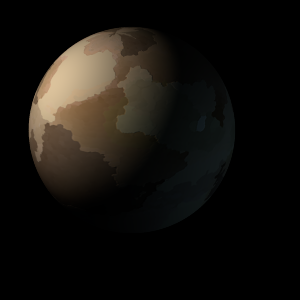|
|
Space Astro
|
Info for exoplanet "Nepa-ta"
| Scientific (actual) data |
|---|
| Planet | Kepler-84 c |
| Planet status | Confirmed |
| Radius | 0.211 |
| Orbital period | 12.883 |
| Semi major axis | 0.108 |
| Orbit eccentricity | 0 |
| Inclination | 88.24 |
| Discovered | 2012 |
| Updated | 2021-02-05 |
| Temperature (kelvin) | 821 |
| Publication | Announced on a website |
| Detection type | Primary Transit |
| Alternate names | 2MASS J19530049+4029458 c, K01589.02, KIC 5301750 c, KOI-1589 c, KOI-1589.02, WISE J195300.48+402945.9 c |
| Star name | Kepler-84 |
| Right ascension | 298.25° |
| Declination | 40.5° |
| Mag v | 15.032 |
| Mag j | 13.583 |
| Mag h | 13.234 |
| Star distance | 1443.27 |
| Star metallicity | -0.2 |
| Star mass | 1.022 |
| Star radius | 1.17 |
| Star temperature | 6031 |
| Star alternate names | 2MASS J19530049+4029458, KIC 5301750, KOI-1589, WISE J195300.48+402945.9 |
| Wikipedia article | Kepler-84 c |
Back
| |
| Fictional info (?) |
|---|
| Suggested name | Nepa-ta |
| Planet type | Warm planet |
| This planet is named after the deity Nepa-ta, the spirit of prosperity.
When viewed from Earth, this proximity to Kepler-84 means the planet can only be seen near the western or eastern horizon during the early evening or early morning.
As seen from Kepler-84, in a frame of reference that rotates with the orbital motion, it appears to rotate only once every two years.
Having almost no atmosphere to retain heat, it has surface temperatures that vary diurnally more than on any other planet in its solar system, ranging from 70°K (-203°C) at night to 560°K (287°C) during the day across the equatorial regions.
As one of the most noticeable objects in the sky, Nepa-ta has been a major fixture in native folklore for as long as records have existed.
The smooth Borealis basin in the northern hemisphere covers 23 percent of the planet and may be a giant impact feature.
Surrounding Nepa-ta is a faint planetary ring system and a powerful magnetosphere. |
| Atmosphere | Hydrogen deuteride (HD) | 62% |
| Hydrogen chloride | 29% |
| Ammonia | 4.9% |
| 2H2O | 2.2% |
| Argon | 0.93% |
| Atmospheric pressure | 90 bar |
 |
| No known satellites |
| Google search for Nepa-ta |
|
Website by Joachim Michaelis
|
|
|
|